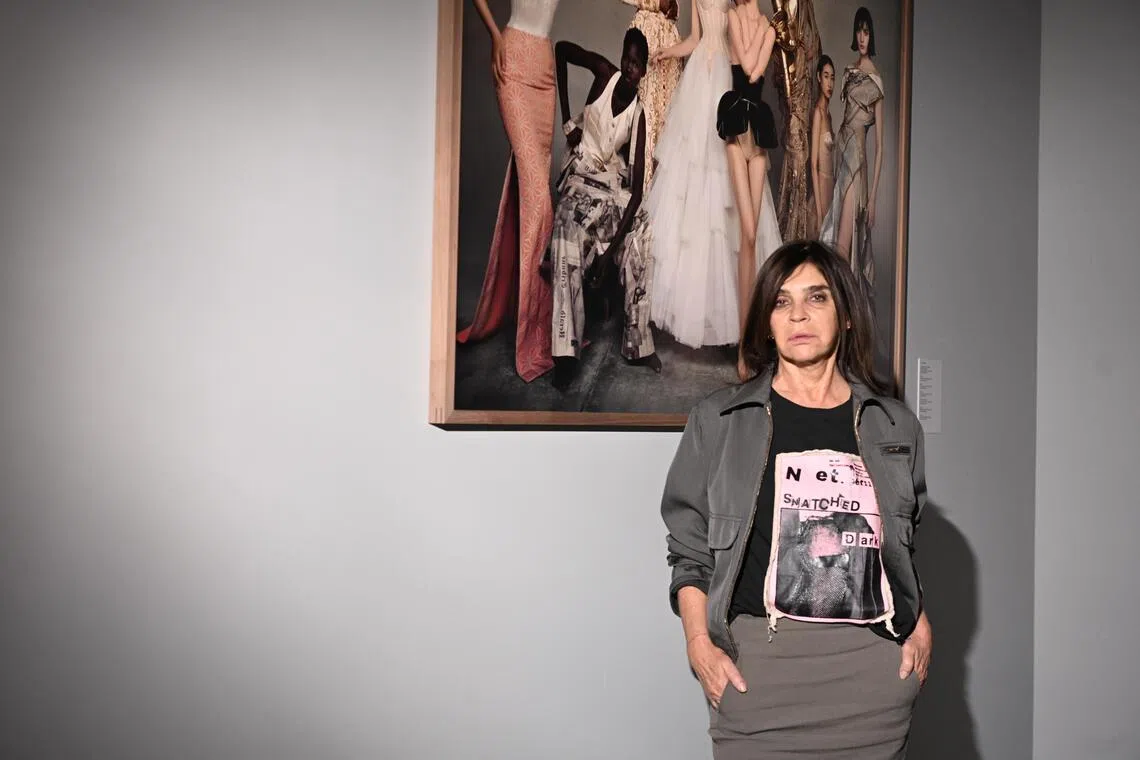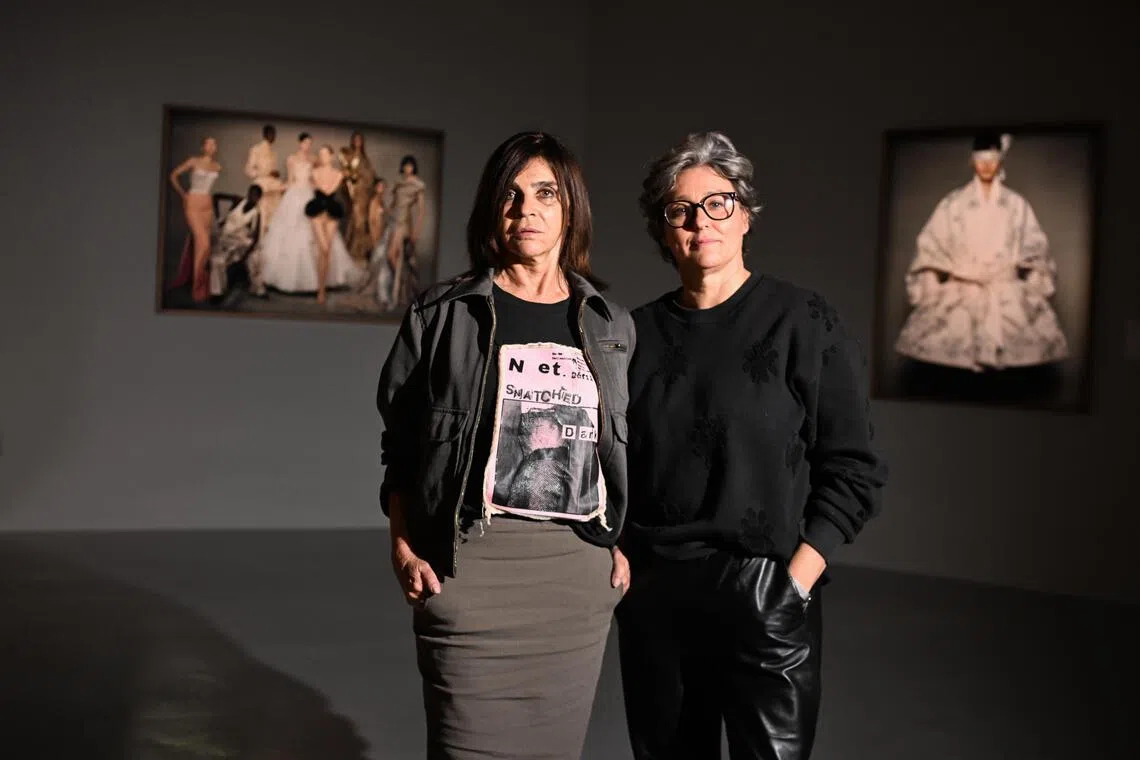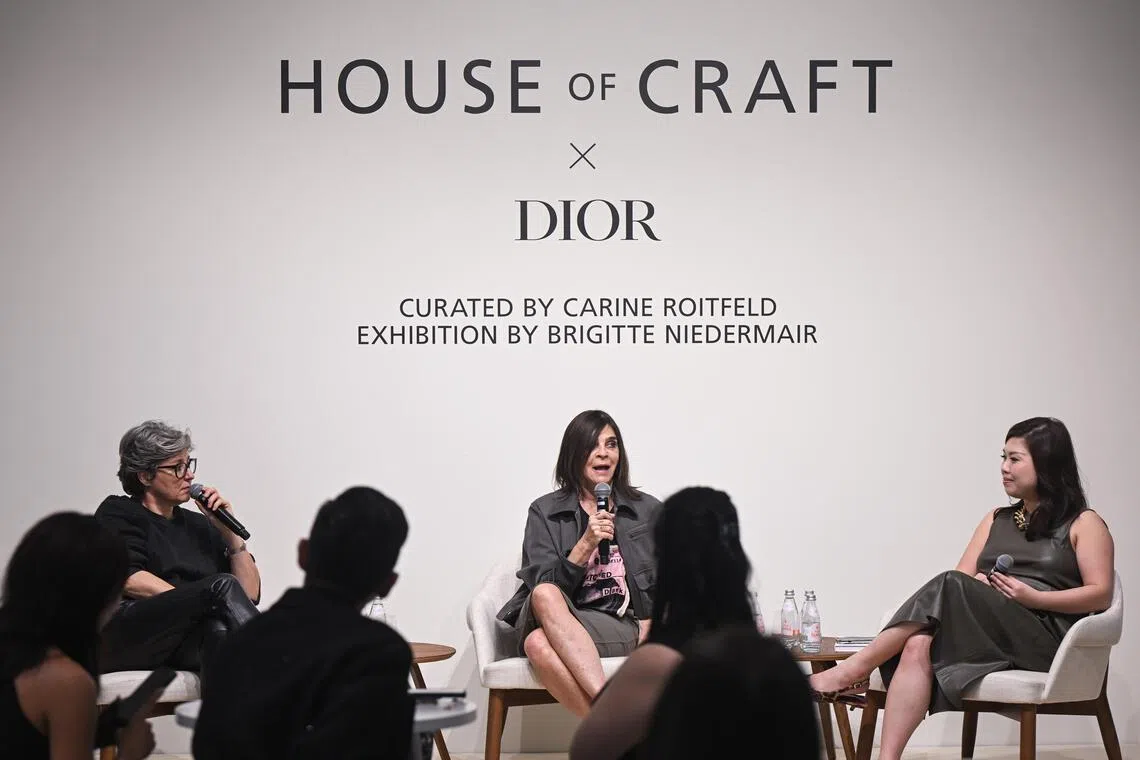Political correctness is not for French Vogue ex-editor Carine Roitfeld. What, then, does she care for?
Sign up now: Get ST's newsletters delivered to your inbox

Former editor of Vogue Paris Carine Roitfeld at the media preview of the UBS House Of Craft x Dior exhibition at Tanjong Pagar Distripark on Nov 18.
ST PHOTO: AZMI ATHNI
Follow topic:
SINGAPORE – The former umpire of taste at French Vogue, Carine Roitfeld, is familiar with scandalous art. Under her rule as editor-in-chief from 2001 to 2011, the fashion title issued busty, smoky and kinky covers that raised hackles in the French suburbs.
But the operative word was always art. She says: “When I’m doing an image and I like what I see, I want to have the picture to frame it up.”
The latest December cover of American Vogue, though – the last by fashion’s iron lady Anna Wintour – is a totally different thing, adds Roitfeld.
American-French actor Timothee Chalamet in a power stance conspicuously edited against a nebula background might have been a successful agitation, but it is not something for your wall, she says.
Roitfeld and her close collaborator, Italian photographer Brigitte Niedermair, are in town for UBS House Of Craft x Dior, the haute couture photo exhibition they co-created, running from Nov 21 to 23 at New Art Museum Singapore in Tanjong Pagar Distripark.
They are fresh off a lengthy media tour of the show when they meet The Straits Times on Nov 18, but still keen to dig into the tenets of good imagery. When Niedermair, 54, suggests that a great picture elicits a conflict of attraction and repulsion in the viewer, Roitfeld sits up.
“You know, they call me the queen of porno-chic,” she says. The 71-year-old Frenchwoman picked up the title for her racy styling work for American designer Tom Ford’s 1990s reinvention of Gucci, which turned the round and brown Italian luxury brand young and hunky.
Citations: A 2003 campaign starring a model’s pubic hair shaved in the shape of a “G”, which a kneeling male model meekly regards. A re-creation of Austrian painter Gustav Klimt’s The Kiss, where the female model is blindfolded, but it is the male who looks submissive.
With a Roitfeld product, you are never quite sure of the power dynamics. “There’s a way to work with sex in pictures. It’s a very fine line to keep it chic because, first, it has to be chic. Not a lot of people are able to hold that line.
“I know I am. So maybe, I have a gift,” she says. Then comes the burn: “I don’t think most of them in the fashion industry knows what chic means any more.”
The instigator of the 2000s’ most rakish womenswear trends, strict pencil skirts, smudged eyeliner and a careless fringe is still in that uniform today, though her dominatrix heels have come down a notch with age and a back injury.
But for Roitfeld, clothes have always been secondary to the woman in them. She has worked with bodybuilders, pink hair (“at the time, it was not common,” says Niedermair), transgender models and untiny women – like Dutch model Lara Stone, who had “too much breasts, too much hips” for the clothing zippers of the time, but was “very emotional in the face”, says Roitfeld.
None of that had anything to do with political values. “I never think about political correctness. It’s not something that enters my mind,” she stresses. It is an attitude she is as leery of as athleisure and the tendency to confuse Paris with France. She is from the former, not the latter, she tells a waiter, after asking him to guess where she is from.
On the resurgence of size 2 bodies in the rag trade, powered by the appetite-suppressing medication Ozempic, she says: “That is for the woman to decide.” It might not be her preference, but her job is to “adapt fashion to the girls”.
The new panic around ageing, exemplified by American reality TV matriarch Kris Jenner’s viral facelift, is something Roitfeld, a grandmother, can judge sympathetically.
“If I am being mean, even though I love Kris as a person, I would ask her to put her hand by her face. Because you can do the lifting of the face, you cannot do the lifting of the hands,” she says.
“But I am lucky, my body did not change much,” she adds.
When Niedermair, with whom Roitfeld seems to work dialectically, says ageing is a privilege that should be honoured, Roitfeld counters, “it is difficult for a woman to accept wrinkles and a gut”.

(From left) Former editor-in-chief of Vogue Paris Carine Roitfeld and photographer Brigitte Niedermair at the media preview of the UBS House Of Craft x Dior in Tanjong Pagar Distripark on Nov 18.
ST PHOTO: AZMI ATHNI
It comes back to what a woman decides to do with her spots, says Roitfeld.
She is less abiding of the iPhone age of fashion, which has coincided with an industry turn towards commerciality over creativity.
When Roitfeld started as a stylist and journalist at the French edition of Elle magazine, fashion advertising did not exist. The last page of the book, usually the most expensive to buy, was reserved for knitting instructions, she says.
Now, brands can loan clothes on the condition they be worn exactly as presented on the runway. You can work around it and try to be “partners making a good magazine today”, but it is difficult, she adds.
And influencers, who have breached the gates of fashion’s power strata, are, to Roitfeld, “obsolete”.
“I think it’s totally demode (passe), the term ‘influencer’,” she says. At fashion shows, the VIP entrance now admits dolled-up influencers before her, “and when you arrive, the doorman asks for your ID. It is not because I have a big ego, no, this is not respectful to people working in fashion.”

Fashion photographer Brigitte Niedermair (left) and former editor-in-chief of Vogue Paris Carine Roitfeld (middle) in a panel discussion at the media preview of the UBS House Of Craft x Dior on Nov 18.
ST PHOTO: AZMI ATHNI
Roitfeld now runs her own ship, CR Fashion Book, a biannual style magazine which Niedermair describes as “one of the last free islands” in fashion.
At Vogue Paris, management wanted to fire her many times – for pushing too hard – says Roitfeld, whose departure from the magazine 14 years ago made global headlines.
“But business-wise, it was doing very well with me.” Now, she is less beholden to brand money, and can make “everything crazy”, she adds.
Her inaugural cover of CR Fashion Book in 2012 had American swimwear model Kate Upton cradling chicks in a low-cut top, her smile unguarded and pointedly unsexual.
There is a trace of that realness in Roitfeld’s grin too, which she dispenses quite readily and without the crocodile quality of more flinty fashion editors.
After all, she has a lot to be pleased about. She would change nothing about her professional life, she says.
“I’m happy to have started my career 40 years ago, because I would not be able to do everything I did if I had to start today.”


